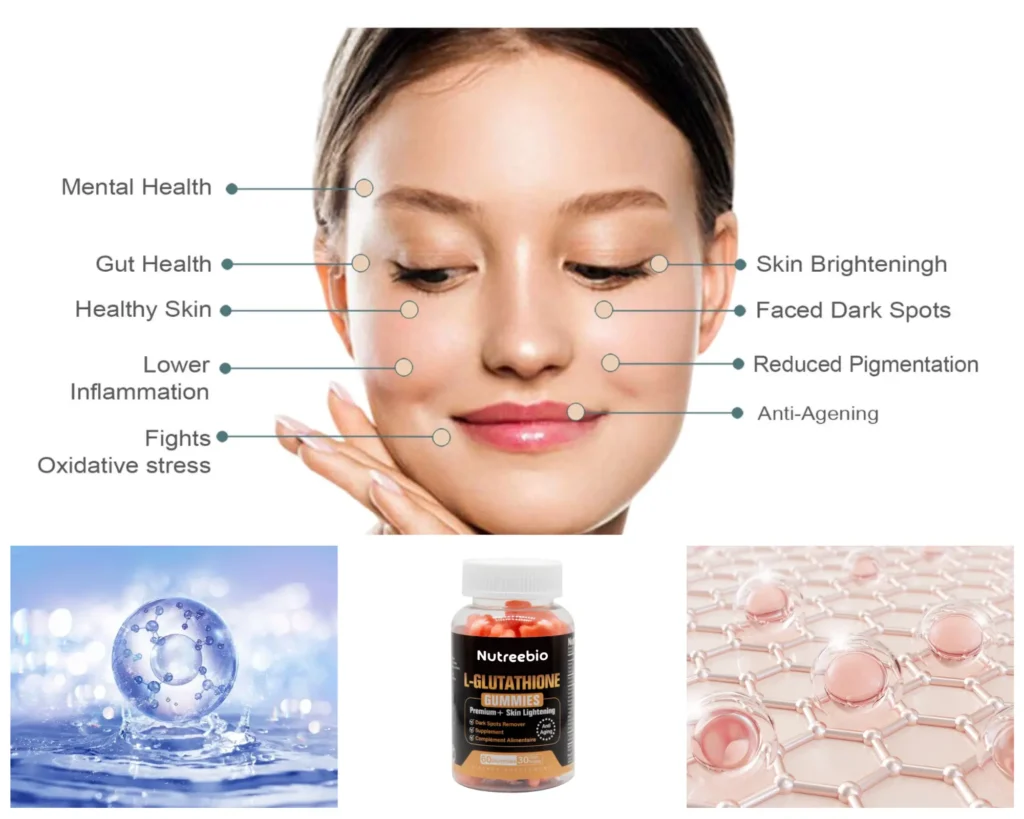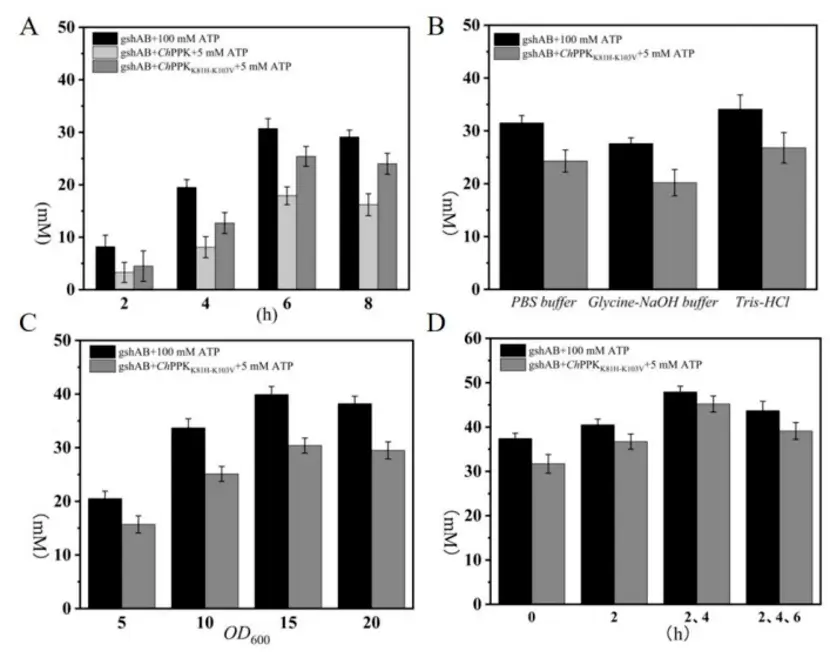Abstract
(1) Benefits of Glutathione
- Antioxidant
- Skin care and whitening
- Anti-aging
(2) Suitable supplemental dosage forms for Glutathione
- Softgel
- Pills
- Tablets
- Gummy
- Powder
(3) Popular countries for Glutathione supplements
- United States
- Canada
- Japan
- South Korea
- Philippines
(4) Extraction technology/method
Glutathione is mainly produced by fermentation, using microorganisms such as Saccharomyces cerevisiae or Streptococcus agalactiae for fermentation. The key steps include:
- Fermentation method: Using Saccharomyces cerevisiae or Streptococcus agalactiae to synthesize glutathione through fermentation. This process involves the catalytic synthesis of glutamate, cysteine and glycine with the assistance of ATP.
- Enzyme catalysis: Using the bifunctional polyphosphate kinase (PPK) to catalyze the reaction of inorganic polyphosphate with ATP, increasing the production and conversion rate of glutathione. By increasing the specific enzyme activity of PPK through site-directed mutagenesis, production efficiency and economic value can be significantly improved.


Article Content
1. Antioxidant effect of Glutathione
Glutathione combines with free radicals through sulfhydryl groups, thereby accelerating the excretion of free radicals. As an important antioxidant in the body, glutathione can remove free radicals from the human body. Since GSH itself is susceptible to oxidation by certain substances, it can protect the sulfhydryl groups in many proteins and enzymes from being oxidized by harmful substances in the body, thereby ensuring the normal physiological functions of proteins and enzymes. Glutathione and lipoic acid both combine with free radicals through sulfhydryl structures, thereby accelerating the excretion of free radicals, and the effect is better with VC and VE.
2. Product dynamics and market prospects
Glutathione can be made into a variety of supplement dosage forms such as Softgel, Pills, Tablets, Gummy, Powder, etc. For example, Core Med Science Liposomal Glutathione Softgels issued by Core contains 500 mg glutathione per capsule. We Like Vitamins and Nature’s Craft have released We Like Vitamins Reduced Glutathione Pills and Nature’s Craft Glutathione Tablets respectively. Glutathione gummy is more extensive and is also the main form of Glutathione as a supplement. L-Glutathione gummy released by Nutreebio has multiple functions such as Supports Antioxidant Defense, Supports Detoxification, Supports Skin Health, etc. BulkSupplements Pure Glutathione Powder releases a pure and high-quality form of glutathione in a convenient powder format.
It is precisely because of the efficacy and dosage form of Glutathione that it has three advantages:
- Strong antioxidant: Glutathione, as an "antioxidant matrix", can effectively neutralize free radicals and protect cell health.
- Multifunctional health support: Glutathione has a significant effect on the immune system, liver detoxification and cell repair, which contributes to overall health.
- High consumer acceptance: A variety of dosage forms meet the needs of different consumers, including soft gel capsules, tablets, troches, gummies and powders.
With these advantages, glutathione supplements are becoming more and more popular in the following countries and regions:
- The United States: Widely used for antioxidant and immune support.
- Canada: Consumer demand for health supplements has increased, and glutathione supplements are popular.
- Japan: The demand for antioxidant and whitening effects has made glutathione popular in beauty and health products.
- South Korea: Due to its skin health and anti-aging effects, glutathione is widely used in skin care and health products.
- Philippines: The Philippines has always had a high demand for skin care and beauty whitening supplements, and we have a lot of cases with Philippine customers.
More and more studies have proven the effectiveness of glutathione in antioxidant, immune support, and cell repair, which has further strengthened consumer confidence. As consumers' health awareness increases, the global demand for antioxidant and immune support products continues to increase, which will continue to drive the growth of the glutathione market in the future.
3. Production technology of Glutathione
GSH is the most abundant non-protein thiol compound in all organisms. It has the ability of antioxidant, detoxifier and immune booster, and is widely used in medical, food and cosmetic industries. The starting strain for fermentation production of glutathione is mainly Saccharomyces cerevisiae. Recently, a glutathione bifunctional enzyme (GshAB) was found in Streptococcus agalactiae, which can directly catalyze the synthesis of GSH from precursors glutamate, cysteine and glycine, accompanied by the consumption of two molecules of ATP. The production of glutathione by fermentation may have problems such as cell membrane barriers, substrate limitations and product transport, and whole-cell catalysis requires the addition of a large amount of ATP, resulting in high costs.
Adenosine triphosphate (ATP) is an essential high-energy phosphate compound in organisms. It provides energy for synthesis, transport, information transmission and other processes in living cells. In enzyme catalysis, ATP usually acts as a cofactor for group transfer and participates in the production of high-value products. In recent years, the reversible reaction of inorganic polyphosphates and ATP catalyzed by polyphosphate kinase (PPK) has attracted much attention. The bifunctional polyphosphate kinase PPK uses cheap and readily available phosphate (polyP) as a substrate and belongs to the PPK2Ⅲ class. It can catalyze adenosine to generate adenosine diphosphate and adenosine diphosphate to generate adenosine triphosphate. How to apply polyphosphate kinase to glutathione production and improve the yield and conversion rate of glutathione has become an urgent problem to be solved.


4. Technical content
To solve the above technical problems, this technology uses molecular docking and site-directed mutagenesis to rationally design to expand the dual substrate polyP6 and ADP channel cavity of polyphosphate kinase and improve the specific enzyme activity of polyphosphate kinase. The polyphosphate kinase mutants obtained by screening are used to produce glutathione, and GshAB and polyphosphate kinase are produced and accumulated by fermentation of bacteria. After collecting bacteria, the cells are broken to obtain lysate. The lysate has the advantages of endogenous ATP-activated regeneration system, avoiding problems such as cell barriers and complex pathway modifications during the intracellular production of glutathione, and quickly reconstructing the production pathway of glutathione in vitro. After coupling the ATP regeneration system, the use of ATP can be reduced, and after optimizing the production system, efficient production of glutathione can be achieved.
The specific enzyme activity of ChPPK before site-directed mutagenesis was 605±2.1 U/mg. After mutation, the double mutant enzyme ChPPKK81HK103V showed the highest catalytic activity, with a specific enzyme activity of 1972±2.5 U/mg. In addition, the regeneration system of ChPPKK81HK103V achieves the unity of high yield, high conversion rate and high economic value of enzyme-catalyzed production of glutathione. After obtaining this efficient PPK mutant enzyme, adding ChPPKK81HK103V to the biocatalytic reaction can significantly improve the efficiency and sustainability of ATP regeneration. After optimizing the system, the catalytic efficiency and substrate conversion rate can be improved, saving the cost of energy-demanding reactions.


